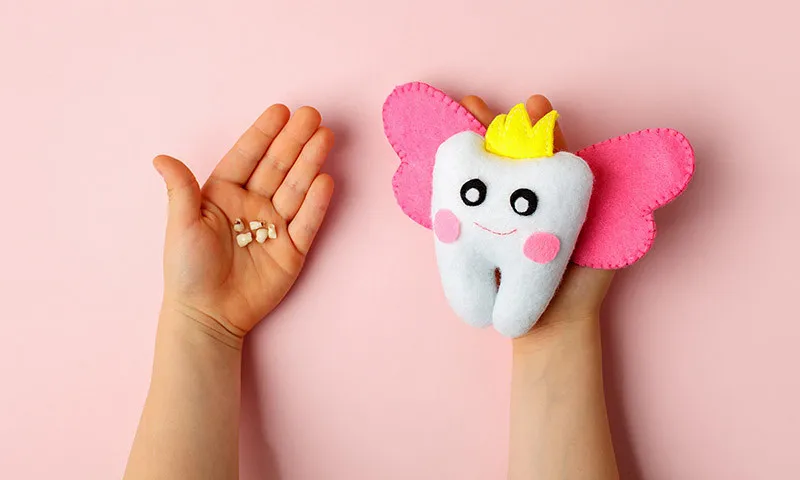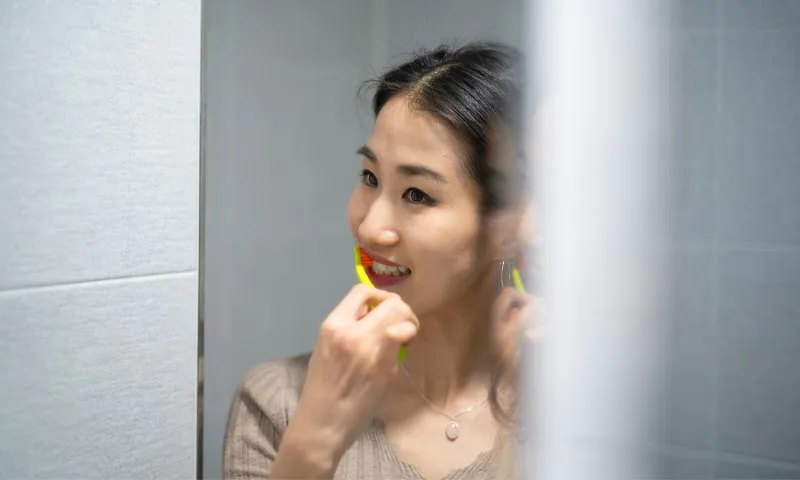Who is the tooth fairy?
The tooth fairy is a mythical creature - similar to the Easter bunny or Father Christmas. The little fairy was born in America. She first appeared in the Chicago Daily Tribune newspaper in 1908. And it was here that her "job" was explained. According to this, the fairy flies into the room of a child who has lost a baby tooth. If the fairy finds the baby tooth under the pillow, she takes it with her and leaves a small gift instead; in the past, this was usually a five cent piece. The fairy and her nightly surprise visits then made another appearance in 1927. This time in a play for children by Esther Watkins Arnold. Gradually, the Tooth Fairy became increasingly well-known and popular beyond America's borders.
Today, the custom described above has become quite individualised. There is not always a small cent under the pillow, sometimes it is a larger sum or a small gift. The tooth fairy is also flexible when it comes to where it is placed. Some children, for example, want to make it particularly easy for her and prefer to place the tooth on the windowsill so that she doesn't have far to travel. Sometimes the Tooth Fairy also leaves the tooth to be collected and doesn't disappear into the night, just as the child pleases. You would think that the tooth fairy would discuss this with the parents in advance...
What does the tooth fairy look like?
Well, that's entirely up to your own imagination. What all children can probably agree on, however, are the little wings with which she floats into children's rooms at night. As the Tooth Fairy became more and more popular when the Disney fairy characters came to the cinemas, it is quite possible that many children have a similar creature in mind when they think of "their" Tooth Fairy.
Good to know:
Did you know that there is an official Tooth Fairy Day? Her day of honour is on 22 August. Unfortunately, she doesn't show up automatically - she only floats down when a baby tooth has fallen out. Perhaps she simply goes on holiday on 22 August...
When will the tooth fairy arrive?
As soon as the first of the 20 milk teeth has fallen out, the tooth fairy sets off. This is usually the case around the time they start school, i.e. at the age of six. However, it can also be the case that the first tooth falls out at the age of five - or doesn't want to come out until the child is seven. Parents don't need to worry about this at all.
When does which milk tooth fall out?
It is interesting to see that the middle and lower incisors usually fall out first. The typical cute gaps between the teeth when laughing, which can often be seen in school photos, then appear. Then the central, upper incisors become loose, as do the lateral, lower incisors. A little later, the lateral upper incisors also fall out. At the very end, it is the turn of the lower canines and molars.
When do the permanent teeth grow back?
The permanent teeth also grow out according to a certain plan. The large molars appear first. You often don't really notice this because no milk teeth have to fall out. At this stage, the milk incisors have often already partly fallen out and the permanent teeth are already emerging. The second phase of tooth change begins at around nine or ten years of age. Now the lateral milk teeth fall out and more molars erupt. Once this phase is complete, the child now has 28 permanent teeth instead of 20 milk teeth. Children are then usually 11 or 12 years old. The wisdom teeth follow later. These teeth usually appear between the ages of 17 and 30 - and in some cases not at all.
Good to know:
Would you like to find out more about how your child's teeth change and whether this can also cause discomfort? Then read on here:
Farewell to the baby tooth: Does the tooth fairy bring a consolation gift?
Why do children traditionally receive a gift for a tooth that has fallen out? This could give rise to the suspicion that they are sad to "let go" of their baby tooth and are perhaps experiencing some form of fear of loss. However, this is not the case at all - and this has even been scientifically proven. A research group at the University of Zurich has discovered that the vast majority of children experience positive feelings when a tooth falls out. The scientists surveyed 1,300 parents. Only 20 per cent of families reported negative experiences.
The researchers also discovered something else exciting: whether children perceive the loss of a baby tooth positively or negatively also depends on their previous experiences at the dentist. If they have bad memories of it - for example, because they were diagnosed with tooth decay - children tend to show fewer positive feelings. The situation is different when children lose a healthy baby tooth. This is a very natural process that takes place gradually: At first the tooth only wobbles a little, then it becomes more and more mobile before it eventually hangs by a single thread and finally comes loose completely. The children experience this process very consciously and with great excitement. They can calmly adjust to the loss of the tooth. These children often feel relief and pride when the tooth has finally fallen out.
This means that the majority of children do not need a "consolation gift" from the tooth fairy to be able to part with their milk tooth. The little surprise is therefore more of a form of recognition for them - a little "winner's gift", so to speak.
Good to know:
Many people think that brushing milk teeth is not so important because they will fall out anyway. This is a fallacy. If milk teeth are infected with caries, the bacteria can spread to the permanent teeth. To prevent this, the right brushing technique is crucial. You can read what it looks like here:
Is it good for children to believe in the tooth fairy?
There is no real answer to this question. Whether parents enjoy this ritual is entirely up to them. And let's be honest, the tooth fairy is not the only fantasy creature that has a permanent place in the lives of many children. Just think of the Easter Bunny, Father Christmas and Father Christmas - who is often supported by the Christ Child.
What we do know, however, is that children begin to believe in such mythical creatures at around the age of three. There are scientists who welcome this and see an advantage in it because such a belief stimulates the imagination. In addition, when deciding "Tooth fairy - yes or no?", the child's environment must also be considered. Do all your little schoolmates firmly believe in the tooth fairy? Then it would be a shame if your own child couldn't take part. The child's enthusiasm for the cause should not be thwarted.
However, there are also critical voices: The fake existence of the tooth fairy could be damaging to the relationship of trust between parents and child. Children could be disappointed if they find out at some point that they have been lied to. A common tip that can be read about this is to address any doubts the child may have and to carefully consider together whether there really is such a little fairy who can carry so many presents at night. In this way, you can slowly approach the truth - without the child losing its dignity in the process.
What presents does the tooth fairy bring? 7 great ideas
What the little tooth fairy has in her luggage at night to make children happy depends entirely on the parents. Some place a coin under the pillow, others perhaps a small figurine or a booklet - similar to the small gifts in a homemade Advent calendar. Still other families place little letters with kind words from the tooth fairy instead of a present. Here we have seven great gift ideas for you that are sure to make your child happy.
Small notebook
The first milk tooth loss often coincides with the start of school. Children start a new stage in their lives and learn to read and write. An exciting time! Now they are also slowly able to write down their thoughts and feelings - even if only in a few simple words at first. To motivate your child to read and write, the tooth fairy can, for example, place a pretty little notebook under their pillow, which is ideal for these first thoughts. You can find the most beautiful little notebooks in many bright colours in stationery shops or online.
Pretty pen
To go with the notebook, a nice pencil can be placed under the pillow for lost baby teeth. It also motivates your child to practise their newly acquired writing skills. Incidentally, so-called magic pens or secret pens with UV light are particularly popular with children of this age. The ink is not visible when writing, but only under ultraviolet light. The pen also comes with a small torch. This little bit of fun also supports primary school children's slowly growing need for more privacy - so they can keep a secret diary!
Children's hourglass
It's a particularly nice idea if the little tooth fairy brings a tooth-related gift. This way, parents can emphasise the importance of good dental hygiene and link it to something positive. How about a nice children's hourglass, for example? They are available in every imaginable colour, decorated with little animals or even with colourful drops instead of sand. With such a pretty clock, the children know exactly how long they have to brush their teeth. This motivates them to persevere and adds to the fun.
Tooth box
Children love collecting! And when it's their own unusual teeth, it's particularly exciting. A great idea - for the first unusual tooth, for example - is to have the tooth fairy present a tooth box. There are lots of lovely variations that are specially designed for this. For example, it could be a pretty little tin box in the shape of a heart or, more professionally, a wooden tooth box with a separate hole for each individual tooth. In the end, you can admire your child's entire set of teeth in it - yes, there really is such a thing!
Fancy children's toothpaste
Yes, toothpaste as a gift can definitely bring joy! Just as we adults can enjoy a special flavour or colour of toothpaste, so can children. Fortunately, there are the most beautiful variations on the market today to make brushing teeth fun for children - for example, the children's toothpastes from Curaprox. Whether strawberry, watermelon or mint; every child will get a taste for it. The best thing about it: with every toothpaste, children also receive a paper model of the mouth that they can put together themselves.
A special children's toothbrush
Brushing your teeth can only be fun if the equipment is right, of course! Here too, you can use the tooth fairy for a good cause by letting her give away a particularly pretty toothbrush. The children's toothbrushes from Curaprox are available in all the colours of the rainbow. But that's not the only thing in their favour: they are specially designed for small children's hands and are particularly gentle on the teeth thanks to their many extra-fine filaments. Of course, the trendy toothbrushes are also free from harmful substances such as bisphenol A (BPA), phthalates and azo dyes.
Little book about brushing your teeth
As you have already learnt above, caring for teeth is important at all times. Regardless of whether there are milk teeth in the mouth, permanent teeth - or both. To teach children the importance of good oral hygiene in a fun way, there are countless great children's books on the market - from small colourful booklets to long stories. Why not browse through the range and see what would make a great little gift for your child from the tooth fairy.
And what happens to the milk tooth? Does the tooth fairy take it away?
It's not just the choice of gift that leaves plenty of room for manoeuvre. Each family can also decide for themselves whether the tooth is left behind by the tooth fairy or taken away. Some children love to collect the little teeth as a memento and are rather sad when the tooth fairy takes them away. Parents should therefore act in the interests of the child and leave them the tooth. Our idea number 4 could be the perfect gift from the tooth fairy for the first tooth that has fallen out: a pretty tooth box.
Important: Before placing the tooth in such a container, you should clean it with a toothbrush and a little toothpaste. Be very careful and avoid cleaning the tooth in the sink under running water. There is a risk of the tooth slipping out of your hand - directly into the drain. This could cause a tear or two. Before the milk tooth finds its final resting place in the tin, it should be completely dry. Simply place it on a kitchen towel or some crepe paper and leave it there for several hours.
Fallen milk teeth as a source of stem cells?
Keeping baby teeth in a tin at home or even letting the tooth fairy disappear with them never to be seen again? That could be a bad idea: Science has discovered milk teeth as a possible source of stem cells. Using a special process in the laboratory, these stem cells contained in milk teeth were able to develop the properties of fat cells, nerve cells and so-called odontoplasts; the latter are responsible for the production of the tooth bone. In mouse experiments, the cultivated cells were able to survive in the brain tissue and even formed bone there. If the results can be confirmed by further studies, the stem cells from milk teeth could potentially be used in various therapies - for example to repair damaged teeth, bones or brain tissue.
However, storing milk teeth in a milk tooth box is not nearly enough to utilise the benefits of stem cells at some point. To do this, the teeth would have to be stored in a specialised laboratory shortly after they fall out. There are actually more and more companies that offer a kind of storage bank. Here the teeth are processed and stored for decades. However, this procedure is very expensive and costs around 2,000 euros for storage for up to 20 years. Tip: Don't be tempted by any internet offers here, but talk to your dentist about your considerations - he or she will give you serious advice.
Tooth fairy study: amounts of money are getting higher, especially in Switzerland
Advent calendars, school report money, tooth fairies: there are plenty of reasons to give children presents. Many parents feel under pressure to be particularly generous. Be it because other families set an example or because they believe this is the only way to show their affection for their child.
An American "tooth fairy study" proves that the amount of money paid for a lost baby tooth is quite impressive globally and continues to rise: In the USA, the tooth fairy brought in an average of USD 4.66 per fallen tooth in 2016 - that was 75 cents more than the year before. In Ireland and Spain, the tooth fairy is not exactly stingy either. Here, children receive 3.75 pounds (4.20 euros) for a milk tooth, and Japanese children can look forward to 525 yen (3.92 euros).
A "tooth fairy study" was also conducted in Switzerland in 2017. The Dental Centre at the University of Zurich asked 1,200 parents about their ritual. Interestingly, only half of the children surveyed believed in the tooth fairy at all - yet they were still given gifts to mark the loss of milk teeth. Also worth noting: Older children and boys were favoured. It was not important for the Tooth Fairy's visit whether the children were good or whether they had brushed their teeth properly. An average of around six euros per tooth is spent on the "tooth fairy event" in Switzerland each year.
Tooth fairy, mouse and co - milk tooth customs around the world
Customs surrounding the falling out of milk teeth have existed for many centuries - but not all of them were as pleasant as the idea of a cute tooth fairy. In the European Middle Ages, for example, instead of such a fairy, people imagined an evil witch who could cast an evil spell on the child if she had the chance to get hold of the baby tooth that had fallen out. Pretty nasty! It is therefore assumed that children of the time buried their baby teeth or burnt them to protect themselves from the evil witch and her dark powers. Not a nice idea.
In the Roman-speaking world, there is the idea of a mouse instead of a fairy. Fortunately, she is just as sweet as the tooth fairy - just like her fairy colleague, she brings a small gift for every milk tooth that falls out. The little mouse is also travelling in Argentina, Sweden, Colombia and South Africa. In the Philippines, however, a rat brings the presents - and in El Salvador there is neither tooth fairy nor mouse: here a rabbit secretly hops into the children's rooms and brings a surprise.
Good to know:
Oh horror! The tooth fairy hasn't come? Maybe she was too tired in the evening, fell asleep on the sofa or worked too late...? Don't panic! If your child's disappointed eyes look at you in the morning, take this brief moment of sadness seriously. Explain to your child that the tooth fairy has a lot to do and may need an extra night. Children are then usually very understanding - and their joy the next morning is even greater.
Sources:
Apollonia Practice Clinic for Dentistry: Where does the tooth fairy come from?
Focus.de: Tooth loss - Every baby tooth counts.
kleiner-kalender.de: Day of the Tooth Fairy 2024.
Landesarbeitsgemeinschaft für Jugendzahnpflege des Freistaates Sachsen e.V.: Day of the Tooth Fairy.
mainzahn - Centre for Dental Health: Don't tell the children: The truth about the tooth fairy.
Merkur.de: How children feel about tooth loss.
praxistipps.focus.de: Storing milk teeth: Why this is a good idea
Spiegel.de: Milk teeth hide multi-talents.
Springer Medizin Verlag: Children are happy about losing their first milk tooth.
Quintessenz Verlags-GmbH: Tooth fairy distributes a fortune every year.
University of Zurich: Children are happy about losing their first milk tooth.
Dentists at Centro: The fairy tale of the tooth mouse.
zwp-online.info: The Swiss tooth fairy is particularly generous.
Abendblatt.de: Why believing in the Easter bunny is good for children.
All websites last accessed on 23.4.24.
 Swiss premium oral care
Swiss premium oral care









